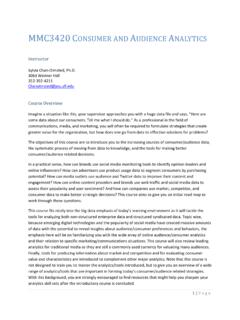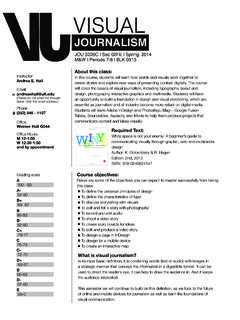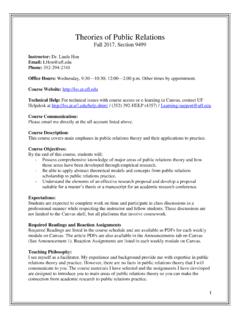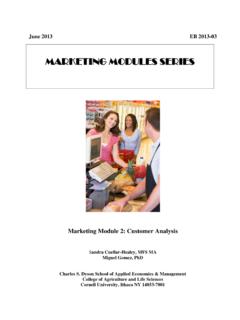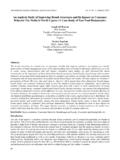Transcription of MMC3420 CONSUMER AND AUDIENCE ANALYTICS …
1 MMC3420 CONSUMER AND AUDIENCE ANALYTICS Instructor Thanos Dimadis Email: Telephone: Introduction If your aspiration is to work as a communication, social media or marketing manager, there is no other way than to obtain a basic but essential knowledge of what big data is, how you can analyze it, and how it can help you to formulate solutions for your company s marketing, communications, media, and digital strategy. If you think that big data and ANALYTICS is too theoretical to carry practical value, you are wrong. We are all part of this online data-driven world where everything we click on, read, like, buy, or comment on as consumers translates into data used by companies to target marketing solutions to us and influence our decision making. From a marketing, communications, branding or media perspective, it is impossible to be efficient and successful if you don t pay attention to data ANALYTICS or don t understand how to interpret and how to use it properly to pursue the best results.
2 If you are hired as the marketing manager of a company or start your own business, you will need to immediately face the challenge of receiving and interpreting many kinds of data. It is critical that you have the knowledge to develop, interpret, and apply this data to improve the company s performance and avoid downside scenarios. Data is everywhere. Everything we do leaves a trail of data behind it, and this data is being tracked by someone somewhere. Many communications, marketing, and digital media professionals underestimate the essential role this plays in every aspect of our lives as consumers. The goal of this course is to prepare you for what you are going to confront in your daily life as a professional in regards to CONSUMER and AUDIENCE ANALYTICS . In other words, at the end of this course, you should be capable of answering questions such as: How does the usage of social media by consumers/ AUDIENCE define the strategic decisions made by brands?
3 How are our habits as consumers used by companies to improve their product management or product development? How is the content of news stories generated by media organizations/outlets affected or influenced by AUDIENCE -driven data through the social media? How do marketing/communications managers and advertisers know what consumers like most about a product and how they can adjust their strategy based on specific customers preferences and needs? And how you can track your competitors' actions, choices, and decisions to improve the outcome of your decision-making? The explosion of new technologies has led to an unprecedented explosion of data availability, multiplying the career opportunities for those professionals who have the skills to transform data into substantial information and insight to improve the performance of businesses and organizations.
4 During this course, you will navigate through different aspects of big data and AUDIENCE / CONSUMER ANALYTICS in today s interconnected digital environment in the fields of marketing and communications. This course is the first step to pave the way towards creating and growing your knowledge of data and ANALYTICS and becoming an data driven thinker. Course Objectives Upon successful completion of the course, you should possess a basic understanding of how to approach CONSUMER and AUDIENCE ANALYTICS within the contemporary workplace. The knowledge you will obtain through this could will be helpful in careers related to ANALYTICS /research, social media, media business, advertising/marketing, and public relations. More specifically, the course aims to make you: 1. Distinguish what Big Data is, what defines it and how it is related to ANALYTICS 2.
5 Understand the interconnectedness of major CONSUMER / AUDIENCE /data concepts with ANALYTICS 3. Comprehend the valuable role of ANALYTICS in digital marketing, communications, and media 4. Understand the critical ANALYTICS tools and processes for developing competitive intelligence 5. Become familiar the basic modeling approaches/metrics for CONSUMER / AUDIENCE segmentation, targeting, positioning, and valuation 6. Learn how to communicate the results of your data and ANALYTICS work with internal and external stakeholders Course Content The course will be divided into the following six modules: module 1: The Building Blocks of CONSUMER and AUDIENCE ANALYTICS This module reviews the characteristics, structure, sources, value, and use of Big Data, as well as its relationship with CONSUMER / AUDIENCE ANALYTICS and business decisions.
6 It also introduces the fundamental concepts in AUDIENCE valuation, CONSUMER behavior and decision making, the impact of digital lifestyles on these decisions/behavior, and the drivers, types, and utilities of ANALYTICS , especial for those used to make CONSUMER segmentation, targeting, and positioning decisions. module 2: Digital Marketing and Communications ANALYTICS This module introduces the major digital marketing and communications ANALYTICS . It reviews the characteristics, value, and use of popular web, social media, search, and mobile app ANALYTICS and discusses the functions of key digital metrics in the context of CONSUMER / AUDIENCE decisions and digital listening/influence analysis. The module also touches on the relationship between digital ANALYTICS and inbound marketing strategies. module 3: Media AUDIENCE and CONSUMER ANALYTICS This module introduces the terminology, data collection, and usage of major AUDIENCE / CONSUMER information and measurement services.
7 It also reviews relevant AUDIENCE psychographic ANALYTICS and how media AUDIENCE behavior and measurement have been impacted by the arrival of digital media. module 4: Competitive Intelligence ANALYTICS This module reviews the nature and utilities of competitive intelligence programs. It introduces the data sources for assessing CONSUMER preferences, firm performance, and market condition and competition. It also discusses the process of utilizing market based ANALYTICS to develop competitive intelligence. module 5: Modeling, Metrics, and ANALYTICS This module reviews the utilities and main approaches for constructing models and metrics to analyze enterprise data, especially for purposes of segmentation, targeting, positioning, and evaluating CONSUMER value. module 6: From Data to Insights Communicating the Analytic Results This module introduces the process of organizing, writing, framing, and refining ANALYTICS reports, delivering effective presentations, and aligning analytic results with stakeholder needs and preferences.
8 Course Structure Using the eLearning environment, this course employs a mixture of contents and learning methods, including lectures, readings, online videos, spreadsheet practices, database searches, and self paced ANALYTICS overviews and exercises from a select number of ANALYTICS vendors. While recorded lectures are devoted to introducing the principles and utilities of major ANALYTICS , other contents are designed to apply the concepts in realistic settings. Note that the focus of this course is not only to introduce you to the major ANALYTICS and tools that are useful in today s Big Data environment, but also to familiarize you with the process of translating data into useful information for better decision making in marketing communications, especially in the digital space. Accordingly, various online video modules from established vendors such as Google ANALYTICS , Hootsuite, Hubspot, and Nielsen are used to supplement the course modules.
9 Upon completion of some of these modules, you will be deemed certified in certain areas based on the vendors criteria. This course will also touch on some basic CONSUMER segmentation, targeting, and positioning modeling approaches. However, the focus of the modeling/metrics segment will not be on the theories or technical applications of the modeling process, but general introduction of the tools and their utilities. No extra credit projects will be available. All assignments are due at the specified dates. Any assignment turned in late will be assessed penalty points per calendar day. Additionally, with respect to assignments, it is assumed that students will present them professionally. This means that students will 4 | Page use proper grammar, word usage, spelling, and content organization. Academic honesty is expected on all assignments and exams.
10 Learning Material All online distributed materials associated with each course module Grade Components 1. Big Data and consumers forum discussion ( module 1) 5% 2. Media AUDIENCE assignment ( module 3) 10% 3. Competitive intelligence group assignment ( module 4) 10% 4. Excel segmentation ANALYTICS assignment ( module 5) 10% 5. Analytic report outline assignment ( module 6) 15% 6. Quizzes ( module 1 5) 30% 7. Online ANALYTICS certifications ( module 2 certification assignments) 20% Final Letter Grades and % A 93 100% A 90 B+ 87 B 83 B 80 C+ 77 C 73 C 70 D+ 67 D 63 D 60 F under 60% UF Policy University Policy on Accommodating Students with Disabilities: Students requesting accommodation for disabilities must first register with the Dean of Students Office ( ).
